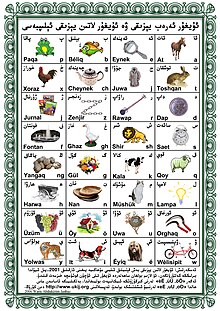Uyghur alphabets
Several Uyghur alphabets are or were used to write Uyghur , at the beginning essentially the Uyghur alphabet , next to Orkhon runes , today mainly an alphabet based on the Arabic alphabet and one based on the Cyrillic alphabet. In the meantime, an alphabet based on the Latin alphabet was also used.
Today two different alphabets are mainly used to write the Uighur language: the Arabic-Persian in China and the Cyrillic in Kazakhstan. A Latin alphabet was once used in Xinjiang for several decades, and is still officially used in China as the Latin transcription of Uyghur today. The spelling conventions of the various writing systems are not compatible with one another; this applies in particular to the writing of Russian and Chinese loanwords.
When the Soviet Union came into being, a Latin alphabet was first developed in 1926 for the Uyghurs living in the Soviet Union. Eleven years later, like all Turkic language alphabets in the Soviet Union, it was replaced by an alphabet based on Cyrillic. After the communists also took power in the People's Republic of China , the Cyrillic alphabet was initially used there as well. However, after the Soviet-Chinese relations cooled down considerably, China decided to go its own way and in 1959 introduced a Latin alphabet based on Pinyin , which avoided digraphs as much as possible and instead used special characters. However, this could not prevail in the Uighur population, and so in 1982 the Arabic script was used again, which is still valid today. In this alphabet, however, unlike when it is used to reproduce the Arabic language and in accordance with the traditional tradition, which comes from the medieval Uighur alphabet, the vowels are also always written. This variant of the Arabic script differs from the so-called Plene writing of Arabic in that only the characters for the half-vowels ( Alif , Waw and Ya ) are used to reproduce the vowels .
Today the Cyrillic script continues to be used in the successor states of the Soviet Union, while the Arabic-Persian script is used in China. A generation of Uyghurs in Xinjiang grew up using the Latin script, which is still used today in China as the official Latin transcription of Uyghur. There are also various new Latin transcriptions, but these have no official status.
The Arabic alphabet for Uighur
Today's Arabic script for writing Uighur has, in addition to the special characters from Persian ("p" and "g"), a number of other special characters, especially for writing vowels .
| # | IPA | Arabic | Cyrillic | Latin |
|---|---|---|---|---|
| 1 | / ɑ / | ئا | А а | A a |
| 2 | / æ / | ئە | Ә ә | Ə ə |
| 3 | / b / | ب | Б б | B b |
| 4th | / p / | پ | П п | P p |
| 5 | / t / | ت | Т т | T t |
| 6th | / d͡ʒ / | ج | Җ җ | J j |
| 7th | / t͡ʃ / | چ | Ч ч | Q q |
| 8th | / x / | خ | Х х | H h |
| 9 | / d / | د | Д д | D d |
| 10 | / r / | ر | Р р | R r |
| 11 | / z / | ز | З з | Z z |
| 12 | / ʒ / | ژ | Ж ж | Ⱬ ⱬ |
| 13 | / s / | س | С с | S s |
| 14th | / ʃ / | ش | Ш ш | X x |
| 15th | / ʁ / | غ | Ғ ғ | Ƣ ƣ |
| 16 | / f / | ف | Ф ф | F f |
| 17th | / q / | ق | Қ қ | Ⱪ ⱪ |
| 18th | / k / | ك | К к | K k |
| 19th | / ɡ / | گ | Г г | G g |
| 20th | / ŋ / | ڭ | Ң ң | Ng ng |
| 21st | / l / | ل | Л л | L l |
| 22nd | / m / | م | М м | M m |
| 23 | / n / | ن | Н н | N n |
| 24 | / h / | ھ | Һ һ | Ⱨ ⱨ |
| 25th | / o / | ئو | О о | O o |
| 26th | / u / | ئۇ | У у | U u |
| 27 | / ø / | ئۆ | Ө ө | Ɵ ɵ |
| 28 | / y / | ئۈ | Ү ү | Ü ü |
| 29 | / w / | ۋ | В в | W w |
| 30th | / e / | ئې | Е е | E e |
| 31 | / ɪ / | ئى | И и | I i |
| 32 | / y / | ي | Й й | Y y |
The characters Ю and außerdem also exist in the Cyrillic alphabet; they correspond to the character strings yu and ya in the Latin alphabet and their corresponding Arabic counterparts.

